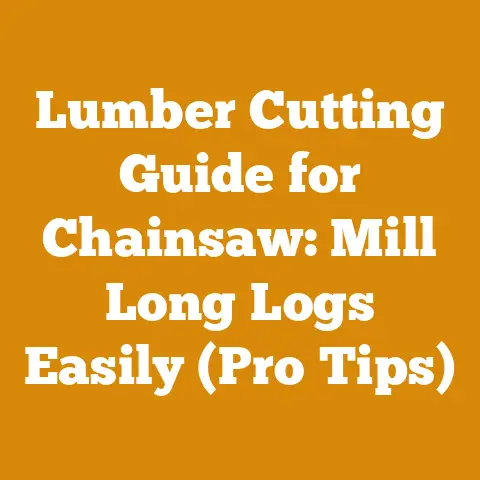Printable Tree Removal Contract Template (5 Pro Tips for Woodworkers)
Printable Tree Removal Contract Template: Your Foundation for Success
A well-drafted contract protects you and your client.
It clearly defines the scope of work, payment terms, liability, and other crucial details.
Think of it as a roadmap that ensures everyone is on the same page before the first cut is made.
Key Components of a Tree Removal Contract
Before we dive into the pro tips, let’s outline the essential elements your tree removal contract template should include:
- Contact Information: Your business name, address, phone number, email, and client’s name, address, and contact details.
Double-check everything! - Scope of Work: This is the heart of the contract.
Be specific about what you’re doing.- Tree Identification: Clearly identify the tree(s) to be removed (species, size, location).
Use photos if possible.
I once misidentified a tree on a property line because the client wasn’t clear.
It was a costly mistake. - Removal Details: Describe how the tree will be removed (felling, sectional dismantling, crane removal).
Mention stump grinding or removal if included. - Debris Removal: State whether you’re hauling away the wood, chipping it, or leaving it on-site.
If leaving it, specify where it will be piled. - Site Restoration: Describe any cleanup or restoration work, such as raking, seeding, or mulching.
- Tree Identification: Clearly identify the tree(s) to be removed (species, size, location).
- Payment Terms:
- Total Price: Clearly state the total cost of the job, including any taxes.
- Payment Schedule: Specify when payments are due (e.g., 50% upfront, 50% upon completion).
- Accepted Payment Methods: List the forms of payment you accept (e.g., cash, check, credit card).
- Late Payment Fees: Include a clause outlining late payment penalties.
- Liability and Insurance:
- Insurance Coverage: State that you have adequate liability insurance to cover any damages or injuries.
I carry a $1 million policy, and I’ve had to use it once when a branch damaged a client’s fence. - Property Damage: Outline your responsibility for any damage to the client’s property.
- Personal Injury: Address liability for injuries to workers or third parties.
- Insurance Coverage: State that you have adequate liability insurance to cover any damages or injuries.
- Permits and Regulations:
- Permit Acquisition: State who is responsible for obtaining any necessary permits.
In many areas, removing trees requires a permit, especially if they are protected species or located in sensitive areas. - Compliance with Local Laws: Ensure that the work complies with all local ordinances and regulations.
- Permit Acquisition: State who is responsible for obtaining any necessary permits.
- Cancellation Policy:
- Cancellation Fees: Outline any fees for cancellation by either party.
- Rescheduling: Explain the process for rescheduling due to weather or unforeseen circumstances.
- Warranty:
- Workmanship Guarantee: Specify any warranty on your workmanship.
- Exclusions: Clearly state any exclusions to the warranty.
- Dispute Resolution:
- Mediation/Arbitration: Outline the process for resolving disputes.
- Governing Law: Specify the state or local laws that govern the contract.
- Signatures and Dates: Both you and the client must sign and date the contract.
Include a witness signature if required by local law.
Creating Your Template
You can create your template using a word processor like Microsoft Word or Google Docs.
Search online for “tree removal contract template” to find a starting point.
Remember to customize the template to fit your specific business and local regulations.
Example Snippet (Scope of Work):
“Contractor agrees to remove one (1) mature oak tree (Quercus alba), approximately 60 feet in height and 36 inches in diameter, located in the backyard of the property at [Client Address].
Removal includes felling the tree, cutting it into manageable sections, and hauling all debris off-site.
Stump grinding to a depth of 12 inches below grade is included.
Site will be raked and cleared of debris upon completion.”
Example Snippet (Payment Terms):
“The total price for the tree removal services is \$3,500.
A deposit of \$1,750 is due upon signing this contract.
The remaining balance of \$1,750 is due upon completion of the work.
Payment may be made by cash, check, or credit card.
A late payment fee of 1.5% per month will be applied to any overdue balances.”
5 Pro Tips for Woodworkers in Tree Removal
Now, let’s get to the practical tips that I’ve honed over years of experience.
These aren’t just about the contract itself but about the entire process of tree removal, from initial assessment to final cleanup.
Pro Tip #1: The Pre-Job Site Assessment – More Than Just a Walk-Around
Before even thinking about a contract, conduct a thorough site assessment.
This is crucial for pricing accurately and identifying potential hazards.
- Tree Inspection: Carefully inspect the tree for signs of disease, decay, or structural weaknesses.
Look for dead limbs, cracks, or cavities.
These factors can significantly impact the removal process and safety.
I once bid a job assuming a healthy tree, only to discover extensive internal rot.
The removal was far more complex and dangerous than anticipated. - Obstacles: Identify any obstacles that could complicate the removal process, such as power lines, fences, buildings, or underground utilities.
Contact your local utility company to mark underground lines. - Access: Assess the access to the tree.
Can you get equipment close enough?
Will you need to use a crane?
Limited access can dramatically increase the cost and time required. - Wood Utilization: Discuss with the client what they want to do with the wood.
Are they interested in keeping it for firewood, milling lumber, or having it hauled away?
This affects your approach to the removal. - Photographic Evidence: Take photos and videos of the tree, surrounding property, and any potential hazards.
This provides valuable documentation in case of disputes.
Data Insight: According to the Tree Care Industry Association (TCIA), improper site assessment is a leading cause of accidents in tree care.
Pro Tip #2: Specifying Wood Processing in the Contract – From Logs to Lumber
As a woodworker, you have a unique opportunity to add value to the tree removal process by offering wood processing services.
This needs to be clearly defined in the contract.
- Milling Options: If the client wants lumber, specify the milling options.
Will you be milling on-site with a portable sawmill, or will you be transporting the logs to a mill?
Include the cost of milling per board foot.- Portable Sawmill Considerations: If using a portable sawmill, ensure you have adequate space and a level surface.
Consider the type of wood being milled.
Hardwoods like oak and maple require more power than softwoods like pine.
I use a Wood-Mizer LT15START portable sawmill, which is great for smaller jobs.
- Portable Sawmill Considerations: If using a portable sawmill, ensure you have adequate space and a level surface.
- Firewood Processing: If the client wants firewood, specify how the wood will be processed (e.g., cut to 16-inch lengths, split, and stacked).
Include the price per cord.- Firewood Splitting Techniques: Explain your splitting method.
Will you be using a manual splitter, a hydraulic splitter, or a combination of both?
Hydraulic splitters, like the Champion 25-Ton Gas Log Splitter, significantly increase efficiency, especially for large-diameter logs. - Firewood Stacking: Detail how the firewood will be stacked.
Will it be stacked in rows, circles, or another configuration?
Specify the dimensions of the stack.
- Firewood Splitting Techniques: Explain your splitting method.
- Wood Ownership: Clearly state who owns the wood after removal.
If you are keeping the wood, specify that in the contract.
I’ve had clients assume they owned the wood even after I quoted the job based on me keeping it. - Waste Disposal: Specify how any waste wood (branches, twigs) will be disposed of.
Will you be chipping it, hauling it away, or burning it (if permitted)?
Case Study: I once removed a large walnut tree for a client who wanted lumber.
I milled the tree on-site using my portable sawmill.
The client received beautiful walnut boards for furniture making, and I kept the remaining lumber for my own projects.
The contract clearly outlined the milling process, costs, and wood ownership, preventing any misunderstandings.
Pro Tip #3: Safety First – Documenting Your Safety Procedures
Tree removal is inherently dangerous. Your contract should reflect your commitment to safety.
- Safety Equipment: State that you will use appropriate safety equipment, including helmets, eye protection, hearing protection, gloves, and chainsaw chaps.
- Industry Standards: Specify that you will follow industry safety standards, such as those established by the American National Standards Institute (ANSI) A300 standard for tree care operations and the Occupational Safety and Health Administration (OSHA).
- Hazard Communication: Outline your procedures for identifying and communicating hazards to your crew and the client.
- Emergency Plan: Have a written emergency plan in place and share it with your crew and the client.
- First Aid: Ensure that you have a well-stocked first-aid kit on-site and that your crew is trained in basic first aid.
- Weather Contingency: Include a clause addressing work stoppage due to inclement weather (high winds, lightning, heavy rain).
Personal Story: I once witnessed a near-fatal accident when a tree fell unexpectedly due to high winds.
The worker was lucky to escape with minor injuries.
Since then, I’ve always included a weather contingency clause in my contracts and prioritize safety above all else.
Pro Tip #4: Insurance and Liability – Protecting Yourself and Your Client
Adequate insurance is essential for any tree removal business.
Your contract should clearly outline your insurance coverage and liability.
- Liability Insurance: State that you have adequate liability insurance to cover any damages or injuries.
Provide the name of your insurance company and your policy number. - Workers’ Compensation Insurance: If you have employees, state that you have workers’ compensation insurance to cover any injuries sustained by your workers.
- Property Damage: Outline your responsibility for any damage to the client’s property.
Specify that you will repair any damage caused by your negligence. - Hold Harmless Clause: Include a hold harmless clause, which protects you from liability for any injuries or damages caused by the client or third parties.
Consult with an attorney to ensure the clause is legally sound in your jurisdiction.
Data Point: According to the Small Business Administration (SBA), one of the leading causes of business failure is inadequate insurance coverage.
Pro Tip #5: The Walk-Through and Final Payment – Ensuring Client Satisfaction
The final walk-through is your opportunity to ensure client satisfaction and secure final payment.
- Thorough Inspection: Conduct a thorough inspection of the work site with the client.
Ensure that all work has been completed according to the contract. - Client Sign-Off: Have the client sign off on the completed work.
This provides documentation that the client is satisfied with the work. - Final Payment: Collect the final payment. Provide the client with a receipt.
- Addressing Concerns: Address any concerns the client may have promptly and professionally.
Go the extra mile to ensure their satisfaction. - Before & After Photos: Take before and after photos of the property.
This provides valuable documentation of the completed work and can be used for marketing purposes.
Insight: Happy clients are your best source of referrals.
A positive experience during the final walk-through can lead to future business and positive word-of-mouth.
Additional Considerations for Woodworkers
Beyond the core contract elements and pro tips, here are some additional considerations specific to woodworkers involved in tree removal:
- Wood Identification: Accurately identify the species of tree.
This is crucial for determining its value and potential uses.
I use a combination of visual identification, leaf samples, and bark characteristics to identify trees. - Wood Moisture Content: Understand the importance of wood moisture content for different applications.
Green wood (freshly cut) is ideal for some turning projects, while seasoned wood (dried) is necessary for furniture making.- Drying Methods: Specify the drying method you will use for lumber.
Air drying is a slower but more cost-effective method, while kiln drying is faster but more expensive. - Moisture Meters: Use a moisture meter to monitor the moisture content of the wood.
The ideal moisture content for furniture making is typically between 6% and 8%.
- Drying Methods: Specify the drying method you will use for lumber.
- Wood Storage: Properly store the wood to prevent decay and insect infestation.
Stack lumber with stickers (spacers) to allow for air circulation. - Sustainable Practices: Consider incorporating sustainable practices into your tree removal and wood processing operations.
This can include using biodegradable chainsaw oil, recycling wood waste, and planting new trees to replace those that are removed.
Example Contract Template Outline
Here’s a basic outline of a tree removal contract template:
Tree Removal Contract
Date: [Date]
Contractor:
- [Your Business Name]
- [Your Address]
- [Your Phone Number]
- [Your Email]
Client:
- [Client Name]
- [Client Address]
- [Client Phone Number]
- [Client Email]
1. Scope of Work:
- Tree Identification: [Description of Tree(s) to be Removed]
- Removal Details: [Description of Removal Process]
- Debris Removal: [Description of Debris Removal]
- Site Restoration: [Description of Site Restoration]
2. Payment Terms:
- Total Price: \$[Total Price]
- Payment Schedule: [Payment Schedule]
- Accepted Payment Methods: [Accepted Payment Methods]
- Late Payment Fees: [Late Payment Fees]
3. Liability and Insurance:
- Insurance Coverage: [Description of Insurance Coverage]
- Property Damage: [Liability for Property Damage]
- Personal Injury: [Liability for Personal Injury]
4. Permits and Regulations:
- Permit Acquisition: [Responsibility for Permit Acquisition]
- Compliance with Local Laws: [Compliance with Local Laws]
5. Cancellation Policy:
- Cancellation Fees: [Cancellation Fees]
- Rescheduling: [Rescheduling Policy]
6. Warranty:
- Workmanship Guarantee: [Workmanship Guarantee]
- Exclusions: [Exclusions to Warranty]
7. Dispute Resolution:
- Mediation/Arbitration: [Process for Dispute Resolution]
- Governing Law: [Governing Law]
8. Signatures:
- Contractor: ____ Date: ___
- Client: ____ Date: ______
Appendix:
- [Photos of Tree(s) to be Removed]
Disclaimer: This is a sample contract template and should not be used as a substitute for legal advice.
Consult with an attorney to ensure that your contract complies with all applicable laws and regulations.
Key Terms Defined
To ensure everyone’s on the same page, let’s define some key terms:
- Green Wood: Freshly cut wood with a high moisture content.
It’s easier to work with for some applications but prone to warping and cracking as it dries. - Seasoned Wood: Wood that has been dried to a stable moisture content.
It’s less prone to warping and cracking and is ideal for furniture making and construction. - Cord: A unit of measurement for firewood, typically 4 feet high, 4 feet wide, and 8 feet long (128 cubic feet).
- Board Foot: A unit of measurement for lumber, equal to 1 inch thick, 12 inches wide, and 12 inches long.
- Stump Grinding: The process of removing a tree stump by grinding it down to below ground level.
- Felling: The act of cutting down a tree.
- Sectional Dismantling: Removing a tree by cutting it into sections, typically used for trees near buildings or power lines.
- Crane Removal: Using a crane to lift and remove a tree, typically used for large or hazardous trees.
- ANSI A300: A set of industry standards for tree care operations developed by the American National Standards Institute.
- OSHA: The Occupational Safety and Health Administration, a federal agency responsible for workplace safety.
Next Steps
Now that you have a solid understanding of tree removal contracts and pro tips, here are your next steps:
- Create Your Template: Use the information in this guide to create your own tree removal contract template.
- Consult with an Attorney: Have an attorney review your template to ensure that it complies with all applicable laws and regulations.
- Practice Your Skills: Practice your tree removal and wood processing skills.
- Get Insured: Obtain adequate liability and workers’ compensation insurance.
- Start Bidding: Start bidding on tree removal jobs.
By following these steps, you can protect yourself, your clients, and your business while providing valuable wood processing services.
Remember, a well-drafted contract is your foundation for success in the tree removal and woodworking industry.
Stay safe, work smart, and always prioritize quality and customer satisfaction.
Good luck!






